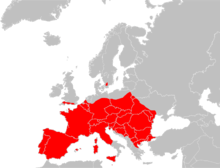Grey long-eared bat
| Grey Long-eared Bat | |
|---|---|
.jpg) | |
| Scientific classification | |
| Kingdom: | Animalia |
| Phylum: | Chordata |
| Class: | Mammalia |
| Order: | Chiroptera |
| Family: | Vespertilionidae |
| Genus: | Plecotus |
| Species: | P. austriacus |
| Binomial name | |
| Plecotus austriacus (J.B. Fischer, 1829) | |
 | |
| Range of P.austriacus | |
The grey long-eared bat (Plecotus austriacus) is a fairly large European bat. It has distinctive ears, long and with a distinctive fold. It hunts above woodland, often by day, and mostly for moths. It is extremely similar to the more common brown long-eared bat, and was only distinguished in the 1960s, but has a paler belly.
Biology and ecology
Its main foraging habitats are lowland meadows and marshes.[2] It locates its insect prey via echolocation. The frequencies used by this bat species for echolocation lie between 18–45 kHz, have most energy at 28 kHz and have an average duration of 5.8 ms.[3]
Conservation
It is currently listed as least concern by the IUCN—its lowest conservation priority. It meets the criteria for this designation because it has a large geographic range and it is considered relatively common. In most of the countries where it is found, it is protected from intentional harm by legislation.[1] While Continental European distributions are not threatened, a 2013 study found this species was close to extinction in the United Kingdom. One possible reason for its decline in the UK is the loss of foraging habitat.[2] This species may also be threatened by climate change in Southern Europe. One researcher noted, "long-lived, slow-reproducing species with smaller population sizes are not likely to be able to adapt to future climate change fast enough through the spread of new mutations arising in the population." In the future, it may be necessary for humans to relocate bats to suitable areas as climate changes.[4]
References
- 1 2 Juste, J.; Karataş, A.; Palmeirim, J.; Paunović, M.; Spitzenberger, F.; Hutson, A.M. (2008). "Plecotus austriacus". The IUCN Red List of Threatened Species. 2008: e.T17597A7158432. doi:10.2305/IUCN.UK.2008.RLTS.T17597A7158432.en. Retrieved 23 February 2013.
- 1 2 Gill, Victoria (5 August 2013). "Rare bat on brink of UK extinction". BBC News. London. Retrieved 23 February 2013.
- ↑ Obrist, Martin K; Boesch, Ruedi; Flückiger, Peter F (2004). "Variability in echolocation call design of 26 Swiss bat species: Consequences, limits and options for automated field identification with a synergetic pattern recognition approach". Mammalia. 68 (4). doi:10.1515/mamm.2004.030.
- ↑ Walter, Kenny (3 August 2017). "Rare Bat in Danger Due to Climate Change". R&D. Advantage Business Media. Retrieved 23 February 2018.
